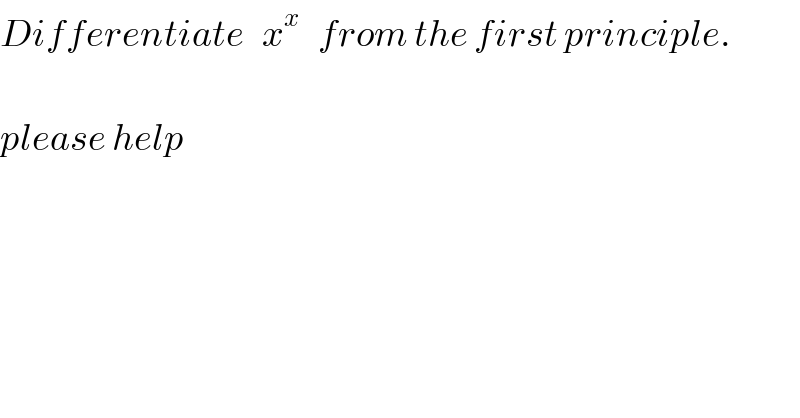
Question Number 5715 by sanusihammed last updated on 24/May/16

$${Differentiate}\:\:\:{x}^{{x}} \:\:\:{from}\:{the}\:{first}\:{principle}. \\ $$$$ \\ $$$${please}\:{help} \\ $$
Answered by Yozzii last updated on 25/May/16

$${Let}\:{y}={x}^{{x}} .\:{If}\:{x}>\mathrm{0}\:{we}\:{can}\:{write} \\ $$$${lny}={lnx}^{{x}} ={xlnx}.\:{Keep}\:{in}\:{mind}\:{that} \\ $$$${y}\:{is}\:{a}\:{function}\:{of}\:{x}.\:{To}\:{differentiate} \\ $$$${the}\:{equation}\:{with}\:{respect}\:{to}\:{x},\:{we}\:{need}\:{to}\:{find} \\ $$$$\frac{{d}}{{dx}}\left({lny}\right)\:\:{and}\:\:\frac{{d}}{{dx}}\left({xlnx}\right). \\ $$$${Let}\:{lny}={u}.\:{Then},\:{by}\:{first}\:{principles}, \\ $$$$\frac{{du}}{{dy}}=\underset{\delta{y}\rightarrow\mathrm{0}} {\mathrm{lim}}\frac{\delta{u}}{\delta{y}}=\underset{\delta{y}\rightarrow\mathrm{0}} {\mathrm{lim}}\frac{{ln}\left({y}+\delta{y}\right)−{lny}}{\delta{y}} \\ $$$$\frac{{du}}{{dy}}=\underset{\delta{y}\rightarrow\mathrm{0}} {\mathrm{lim}}\frac{{ln}\left(\mathrm{1}+\frac{\delta{y}}{{y}}\right)}{\delta{y}}=\underset{\delta{y}\rightarrow\mathrm{0}} {\mathrm{lim}}{ln}\left(\mathrm{1}+\frac{\delta{y}}{{y}}\right)^{\mathrm{1}/\delta{y}} \\ $$$$ \\ $$$${Let}\:{k}=\delta{y}/{y}\Rightarrow\delta{y}={yk} \\ $$$$\frac{{du}}{{dy}}=\underset{{k}\rightarrow\mathrm{0}} {\mathrm{lim}}\left(\mathrm{1}+{u}\right)^{\mathrm{1}/\left({yk}\right)} =\frac{\mathrm{1}}{{y}}\left\{\underset{{k}\rightarrow\mathrm{0}} {\mathrm{lim}}{ln}\left(\mathrm{1}+{k}\right)^{\mathrm{1}/{k}} \right\} \\ $$$${let}\:{k}=\mathrm{1}/{n}. \\ $$$$\therefore\frac{{du}}{{dy}}=\frac{\mathrm{1}}{{y}}\left\{\underset{{n}\rightarrow\infty} {\mathrm{lim}}{ln}\left(\mathrm{1}+\frac{\mathrm{1}}{{n}}\right)^{{n}} \right\}=\frac{\mathrm{1}}{{y}}{ln}\left\{\underset{{n}\rightarrow\infty} {\mathrm{lim}}\left(\mathrm{1}+{n}^{−\mathrm{1}} \right)^{{n}} \right\}=\frac{\mathrm{1}}{{y}}{lne} \\ $$$$\Rightarrow\frac{{du}}{{dy}}=\mathrm{1}/{y}.......\left(\mathrm{1}\right) \\ $$$$ \\ $$$${Now},\:\frac{{du}}{{dx}}=\frac{{du}}{{dy}}×\frac{{dy}}{{dx}}\:{according}\:{to}\:{the}\:{chain}\:{rule}. \\ $$$${PROOF}:\:{From}\:{first}\:{principles} \\ $$$$\frac{{du}}{{dx}}=\underset{\delta{x}\rightarrow\mathrm{0}} {\mathrm{lim}}\frac{\delta{u}}{\delta{x}}=\underset{\delta{x}\rightarrow\mathrm{0}} {\mathrm{lim}}\left(\frac{\delta{u}}{\delta{y}}×\frac{\delta{y}}{\delta{x}}\right)=\left(\underset{\delta{x}\rightarrow\mathrm{0}} {\mathrm{lim}}\frac{\delta{u}}{\delta{y}}\right)\left(\underset{\delta{x}\rightarrow\mathrm{0}} {\mathrm{lim}}\frac{\delta{y}}{\delta{x}}\right) \\ $$$${If}\:{y}={f}\left({x}\right)\:{such}\:{that}\:\delta{y}={f}\left({x}+\delta{x}\right)−{f}\left({x}\right) \\ $$$$\Rightarrow\:{as}\:\delta{x}\rightarrow\mathrm{0},\:{f}\left({x}+\delta{x}\right)−{f}\left({x}\right)\rightarrow\mathrm{0}\:{or}\:\delta{y}\rightarrow\mathrm{0}. \\ $$$$\therefore\:\underset{\delta{x}\rightarrow\mathrm{0}} {\mathrm{lim}}\frac{\delta{u}}{\delta{y}}=\underset{\delta{y}\rightarrow\mathrm{0}} {\mathrm{lim}}\frac{\delta{u}}{\delta{y}}=\frac{{du}}{{dy}}\:{and}\:\underset{\delta{x}\rightarrow\mathrm{0}} {\mathrm{lim}}\frac{\delta{y}}{\delta{x}}=\frac{{dy}}{{dx}}. \\ $$$$\Rightarrow\frac{{du}}{{dx}}=\frac{{du}}{{dy}}×\frac{{dy}}{{dx}}.\:\:\:\:\:\:\:\:\:\:\:\:\:\:\:\:\:\:\:\:\:\:\:\:\:\:\:\:\:\:\:\:\:\:\:\:\:\:\:\:\:\:\:\:\Box \\ $$$$ \\ $$$$\therefore\:\frac{{du}}{{dx}}=\frac{{d}\left({lny}\right)}{{dx}}=\frac{{d}\left({lny}\right)}{{dy}}×\frac{{dy}}{{dx}}=\frac{\mathrm{1}}{{y}}\bullet\frac{{dy}}{{dx}}. \\ $$$${Now}, \\ $$$$\frac{{d}\left({xlnx}\right)}{{dx}}=\underset{\delta{x}\rightarrow\mathrm{0}} {\mathrm{lim}}\frac{\left({x}+\delta{x}\right){ln}\left({x}+\delta{x}\right)−{xlnx}}{\delta{x}} \\ $$$$\:\:\:\:\:\:\:\:\:\:\:\:\:\:\:\:\:=\underset{\delta{x}\rightarrow\mathrm{0}} {\mathrm{lim}}\frac{{xln}\left({x}+\delta{x}\right)−{xlnx}+\delta{xln}\left({x}+\delta{x}\right)}{\delta{x}} \\ $$$$\:\:\:\:\:\:\:\:\:\:\:\:\:\:\:\:\:=\underset{\delta{x}\rightarrow\mathrm{0}} {\mathrm{lim}}\left\{\frac{{x}}{\delta{x}}{ln}\left(\mathrm{1}+\frac{\delta{x}}{{x}}\right)+{ln}\left({x}+\delta{x}\right)\right\} \\ $$$$\:\:\:\:\:\:\:\:\:\:\:\:\:\:\:\:\:={x}\left\{\underset{\delta{x}\rightarrow\mathrm{0}} {\mathrm{lim}}\frac{\mathrm{1}}{\delta{x}}{ln}\left(\mathrm{1}+\frac{\delta{x}}{{x}}\right)\right\}+{ln}\left({x}+\mathrm{0}\right) \\ $$$${We}\:{just}\:{found}\:{the}\:{result}\:{of}\:\underset{\delta{y}\rightarrow\mathrm{0}} {\mathrm{lim}}\frac{\mathrm{1}}{\delta{y}}{ln}\left(\mathrm{1}+\frac{\delta{y}}{{y}}\right)=\frac{\mathrm{1}}{{y}}\:{from}\:\left(\mathrm{1}\right). \\ $$$${Hence},\:{similarly}\:\underset{\delta{x}\rightarrow\mathrm{0}} {\mathrm{lim}}\frac{\mathrm{1}}{\delta{x}}{ln}\left(\mathrm{1}+\frac{\delta{x}}{{x}}\right)=\frac{\mathrm{1}}{{x}}. \\ $$$$\Rightarrow\frac{{d}\left({xlnx}\right)}{{dx}}={x}×\frac{\mathrm{1}}{{x}}+{lnx}=\mathrm{1}+{lnx}\:\left({x}>\mathrm{0}\right) \\ $$$$\therefore\frac{\mathrm{1}}{{y}}×\frac{{dy}}{{dx}}=\mathrm{1}+{lnx}\Rightarrow\frac{{dy}}{{dx}}={y}\left(\mathrm{1}+{lnx}\right)={x}^{{x}} \left(\mathrm{1}+{lnx}\right) \\ $$$$ \\ $$$$ \\ $$
